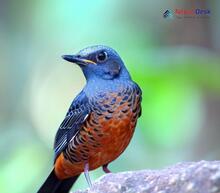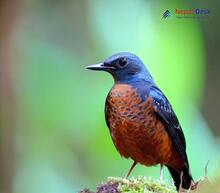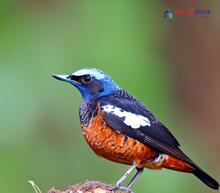Tucked away within Nepal's diverse and awe-inspiring landscapes lies a valuable secret – the Monticola genus of birds. Often overshadowed by their reclusive nature, these incredible creatures play a vital role in Nepal's rich biodiversity. Here, we'll delve into the captivating world of the Monticola genus and examine its distinct connection with the Nepali environment.
A voyage through the Monticola genus
The Monticola genus encompasses several species of thrush-sized birds scattered across Asia and Europe. These species are typically recognized by their eye-catching plumage – ranging from brilliant blues to vivid reds – and their fondness for rocky habitats. In Nepal, two primary species can be observed: the White-throated Redstart (Monticola gularis) and the Blue Rock Thrush (Monticola solitarius).
The White-throated Redstart, true to its name, features an unmistakable white throat patch that contrasts with its predominantly black and red body. This striking bird is often found in high-altitude shrublands where rocky terrain offers plenty of opportunities to forage for insects.
In contrast, the Blue Rock Thrush dons an equally stunning deep blue plumage. This versatile bird has been known to reside in various habitats across Nepal, from high mountain cliffs to more urban environments.
Adapting to life in Nepal
A crucial factor behind Monticola species' thriving existence in Nepal is their inherent adaptability. Both the White-throated Redstart and the Blue Rock Thrush inhabit altitudes up to 4,000 meters above sea level, enabling them to flourish within Nepal's varied topography.
Fascinatingly, these species also exhibit unique territorial behaviors. Males often belt out loud songs from exposed perches or partake in impressive aerial displays during mating season to assert dominance and attract mates.
The Monticola genus and conservation
Due to their relatively secretive nature and widespread distribution, obtaining accurate population estimates for the Monticola genus in Nepal can be quite a challenge. Nevertheless, as with numerous other wildlife species, habitat loss caused by human development poses a considerable threat to these birds.
As our exploration and appreciation of Nepal's incredible biodiversity continue, gaining a deeper comprehension of the Monticola genus's distinct needs and habitats will become increasingly crucial. By protecting these magnificent birds, we also contribute to preserving the rich natural legacy of the country.
In conclusion
While Monticola birds might not be as famous as other native species in Nepal, they serve as a brilliant example of the nation's extraordinary biodiversity. As we keep unveiling more about these alluring creatures and their intricate relationships with their surroundings, it becomes increasingly vital to safeguard these delicate ecosystems for future generations to marvel at.




